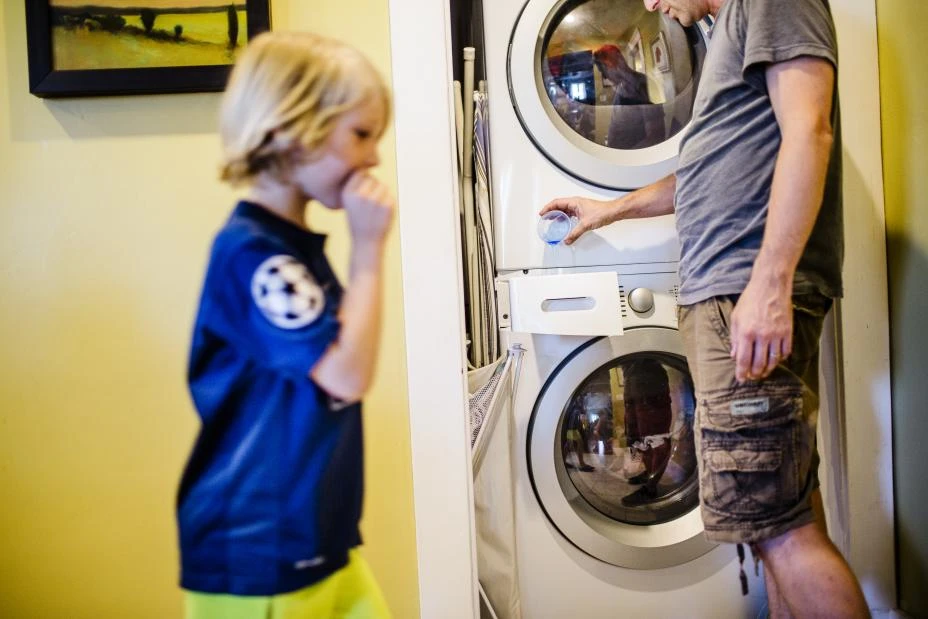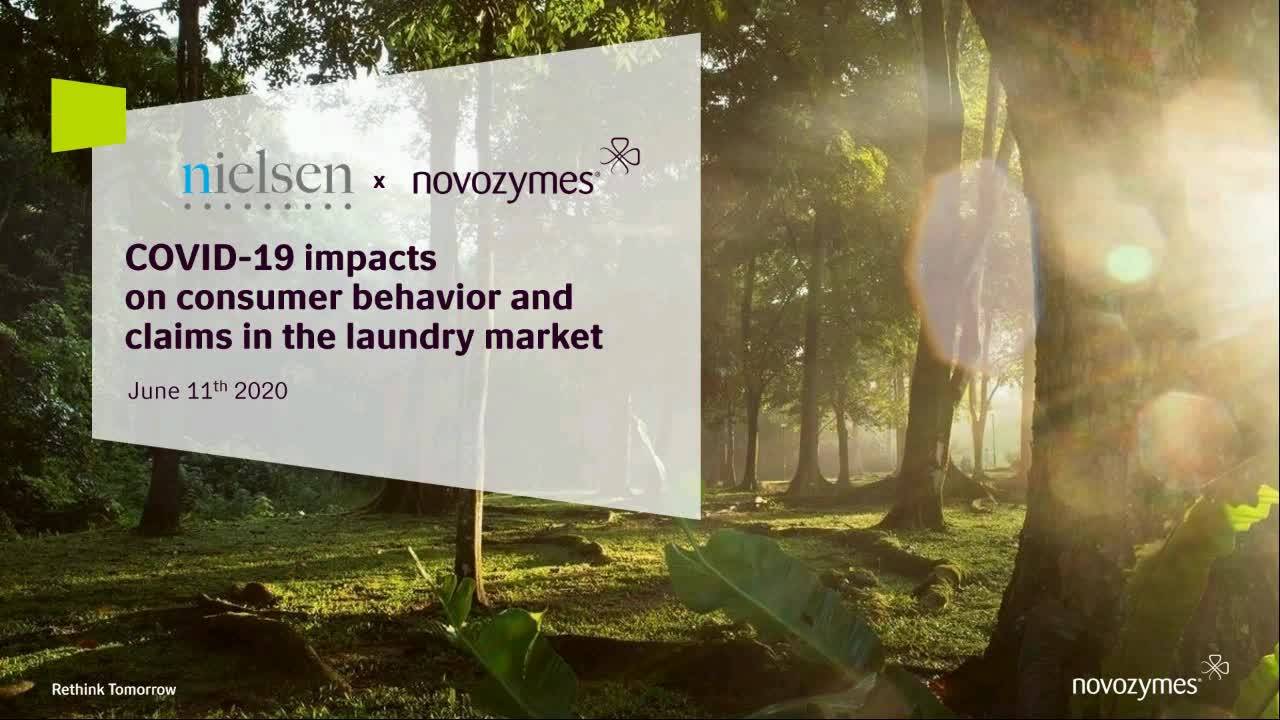This article summarizes a webinar, "COVID-19 impacts on consumer behavior and claims in the laundry market", given by Novozymes & Nielsen on June 11, 2020. Click here to view the video.
Which claims will command attention in the post-COVID laundry market?
As we continue to adapt and respond to the challenges posed by COVID-19, several intriguing consumer trends have emerged.
In particular, the Household Care industry is rapidly expanding, with week-over-week sales consistently logging 20% growth compared to the previous year.
Two key factors causing this surge:
-
The rise of the “Homebody Economy.” Due to stay-at-home orders, consumers are spending more time at home, resulting in a greater need to clean around the house
-
The link between household care products and cleanliness. “Clean” is now tied to “safe,” because consumers are associating it with exterminating viruses and other unwanted microbes
In light of these developments, you may be wondering what kinds of products this new breed of consumers will be looking to purchase and how much they’re willing to pay. You may have also sensed that it’s time to adjust your marketing claims.
At Novozymes, our mission is to make that process easy.
That’s why we’ve teamed up with our research partners at Nielsen to identify long- and short-term plays that align your claims perfectly with new consumer preferences.
Feel free to use this article as a cheat sheet for your brand strategy in a post-COVID world.
1. Continue investing in innovation
In times of crisis, it’s tempting to shelve R&D because its impact on your bottom line feels risky and uncertain.
Don’t fall for this trap.
Innovation is currently driving sales across household care categories, which means now is actually the right time to double down on R&D.
According to Nielsen’s Innovation Performance Measurement, the industry innovation rate has decreased by 16% since the start of the pandemic. However, sales generated from innovations still account for the same portion of total sales when compared to sales this time last year. Key takeaway: Innovative products are more resilient during times of uncertainty.
This is backed up by McGraw Hill’s research on company performance, which shows that consumers’ interest in innovation is largely unaffected by world events. If they see the value in your product, they will buy it whether or not COVID-19 is wreaking havoc.
Bottom line: Consumers are still receptive to new products even in times of recession. Keeping your foot on the innovation pedal is a smart move for both your short- and long-term financials.
2. Emphasize health and safety
Prior to COVID-19, consumers based their household care purchases on brand quality, trust and naturalness.
But in the last few months, they’ve shifted their preferences. According to a March 2020 Nielsen Global Survey study, consumers are now looking for products that provide the following:
-
Protects my family from germs and diseases
-
Kills germs effectively and naturally
-
Keeps my immune system strong
That means it’s time to build your claims around health and safety.
One great way to do this is by incorporating enzymes into your product. Why enzymes? Because they satisfy current consumer preferences.
Novozymes regularly helps our customers translate the benefits of enzymes to claims that fit the product concept and trigger consumers’ willingness to pay. In the past, we’ve found that certain claims enable you to increase your prices by as much as 33% for laundry detergents.
In our recent webinar, we compared the results of the same claim study conducted before and after COVID-19 outbreak. One specific insight we uncovered was that consumers are increasingly looking for exceptional stain removal benefits in their detergent. Head here for more info.
Reach out to a Novozymes account manager to find out how we can help you create claims that capture consumer attention effortlessly.
3. Reposition fabric care claims
How can laundry brands fulfill their consumers’ need to stay safe and healthy during the pandemic?
In addition to marketing exceptional stain cleaning abilities, home care brands can stand out with fabric care benefits.
This is because consumers are increasingly concerned with microscopic particles trapped in their clothes. While there is currently no evidence that clothes transmit the virus, many states’ stay-at-home orders have prompted consumers to set clear boundaries between their home and the outside world. This has made them increasingly conscious about bringing contaminants into the house.
To meet consumers’ desires in this area, change your claims from “fabric and color care” to “microscopic clean,” and “whitens clothes” to “exceptional stain fighting.” The good news is that the same enzymes that allow you to claim hygiene and safety also allow you to claim these fabric care benefits.
4. Redefine shopper personas
The final factor to consider for adjusting your claims is that different shoppers have different preferences.
While Novozymes’ pre- and post-COVID studies outline the big picture shift in claim preference, keep in mind that successful strategies are customized to your brand and your target shoppers.
Also note that traditional demographic segmentation is no longer relevant. In response, Nielsen has identified five new shopper personas based on their experiences and behavior changes during COVID-19:
-
Health-minded shoppers: consumers who avoid crowds.
-
Conscientious store shoppers: consumers who stick to stores taking additional measures to ensure store cleanliness and keep supplies in stock.
-
Regular routine rebounders: consumers who believe everything will return to normal soon.
-
At-risk solution seekers: consumers concerned about maintaining household income who purchase products they don’t usually buy.
-
Stressed strugglers: consumers who are struggling financially and may have recently lost their job.
Important elements to consider include income vulnerability, job status and health risks. Also be sure to acknowledge changes in behavioral tendencies, including shifts towards embracing value/dollar channels, preference for private labels and increased online spending.
The more relevant your claims are to your audience’s concerns, the more your brand resonates.
Speed is key
Our internal assessment indicates a 2-4% growth potential for the post-COVID U.S. laundry detergent market.
Companies are starting to realize the opportunity the recent environment has created, which means it’s critical to act quickly if you want to capture value.
Novozymes has studied, analyzed and strategized the best ways to command consumer attention and maximize sales. We’ve committed substantial resources to this task and we’re eager to share our tactics with you.
Reach out to your Novozymes team and we’ll work with you on reaching your customer base efficiently and effectively.




